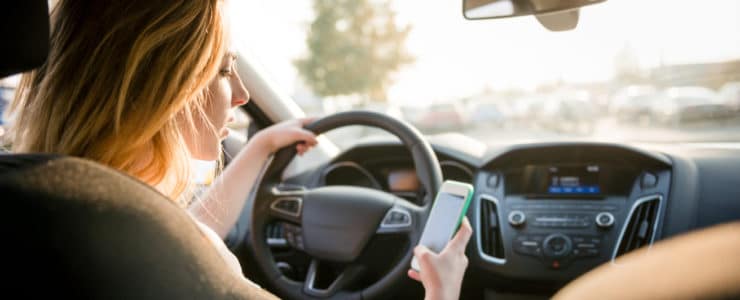
Since at least the early 2000s, we’ve seen a significant increase in distracted driving. The increase took a significant jump due to electronic devices brought into (or built into) vehicles, cell phones, and navigation devices, in particular. We should note that since cars were invented, there has always been distracted driving. Let’s take a look at examples of distracted driving, and see how many of them sound like what you’ve experienced:
- Smoking, eating, or drinking
- Grooming (shaving, adjusting your hair, or applying make-up)
- Moving objects in the vehicle (pets, for example)
- Adjusting controls (climate, audio, etc.)
- Phone calls or texting
- Other occupants (especially babies and children)
- Objects, people, or events outside of your vehicle
- General distraction or lost in thought
- Feeling ill or fatigued
Any of these can cause you to be distracted, though some are much more significant. When you are operating a vehicle, that should be your primary focus…driving safely, protecting yourself, your passengers, and others outside of your vehicle. Because so many drivers do not, the insurance industry notes that 25% of all crashes involve making a phone call and another 18% involve texting. Distracted driving accounts for between 4,000 and 8,000 accidents in the U.S. per day! The other categories of distractions comprise a much smaller percentage of total accidents.
There are several other causes of distracted driving:
- Complacency. Perhaps you’ve been driving for years or decades. Each time you buckle up your seatbelt, tell yourself that your primary duty is to pay attention to the road and focus on driving. If you don’t arrive at your destination safely or at all, nothing else matters.
- Different vehicles. When you get a new vehicle, are driving a rental car, or borrowing a friend’s car, it will be a different driving experience for you. Pay particular attention to these situations. Take time before driving to properly adjust your driving and steering wheel positions, set your mirrors, adjust the climate control, etc., before you take off.
There’s been significant research about distracted driving, including identifying causes of distractions, the significance of specific distractions, and attitudes toward distracted driving. Here are some of those findings:
- The National Highway Traffic Safety Administration reports more than 3,000 deaths and 416,000 injuries annually can be attributed to distracted driving.
- The National Safety Council found that speaking on a call while driving reduces focus on the road and overall driving by 37%. It did not matter if the person driving was holding the phone or using hands-free technology.
- The U.S. Department of Transportation estimates that merely reaching for a phone can take the driver’s eyes off the road for nearly five seconds, which at 55 miles per hour, equates to a distance equal to a football field.
- Interestingly, the American Automobile Association found that talking to a passenger was as distracting as making a hands-free phone call!
- Monash University found that having one or more children in the vehicle was a whopping 12 times more distracting than having a phone call.
Research is also revealing some trends you may find surprising. You may assume that younger drivers (18-24), who are extremely familiar with technology, have high rates of calling and texting while driving; they do. However, when looking at drivers ages 35-44, they too have high rates of calling and texting while driving. So, it’s not only a young-driver problem. Phone calls and texting while driving is prevalent among all sexes and ages.
Well, it’s not feasible to always drive alone, and we cannot control what we see out the window that may catch our attention. What can you do to minimize distractions while driving?
- Turn your phone on Do Not Disturb before taking the vehicle out of park. Use the available features on newer cell phones that restrict incoming and outgoing calls while driving.
- Minimize your interactions with navigation tools. Program your destination while parked, and don’t use your system to search for gas stations or ATMs while driving. If you have a front-seat passenger, let him or her navigate the way.
- NEVER look at your phone to read or send a text message while driving.
- Pull into a parking lot if you must make a call or send a text message.
- Secure your passengers, pets, and any loose objects inside your vehicle before starting driving.
- Use steering wheel controls for climate and radio adjustments, if you have these.
- Avoid disturbing or dramatic conversations while driving.
While distractions have always been and will always be a part of driving, attempting to minimize those distractions is the most proactive step you can take. Make a commitment to yourself that you will not use your smartphone to make or receive phone calls or text messages while driving, including while sitting at a traffic light. Be mindful of how much attention you’re actively spending driving instead of looking around and interacting with things and people inside your vehicle. Finally, share this information with your friends and family members so they can recognize the dangers and minimize distractions as they drive.
Sources:
https://en.wikipedia.org/wiki/Distracted_driving
https://safestart.com/news/top-10-causes-distracted-driving-and-what-they-all-have-common/
https://www.insurancehotline.com/resources/distracted-driving/


